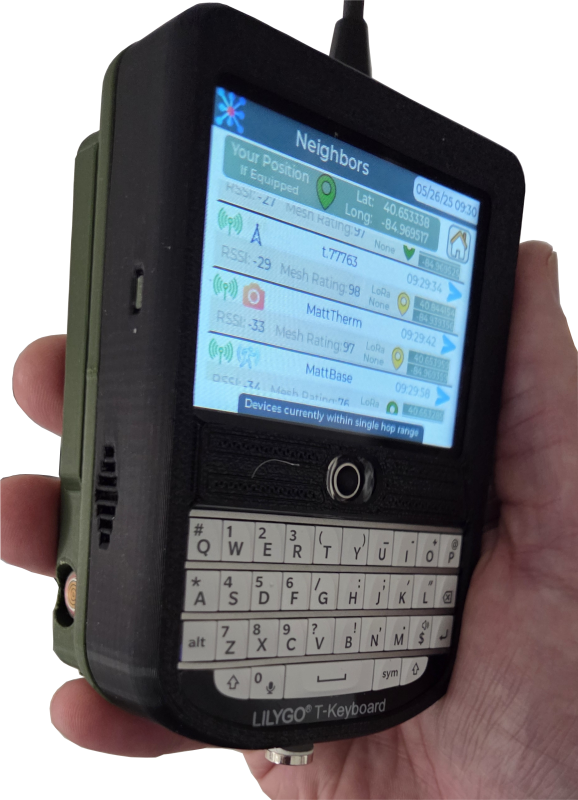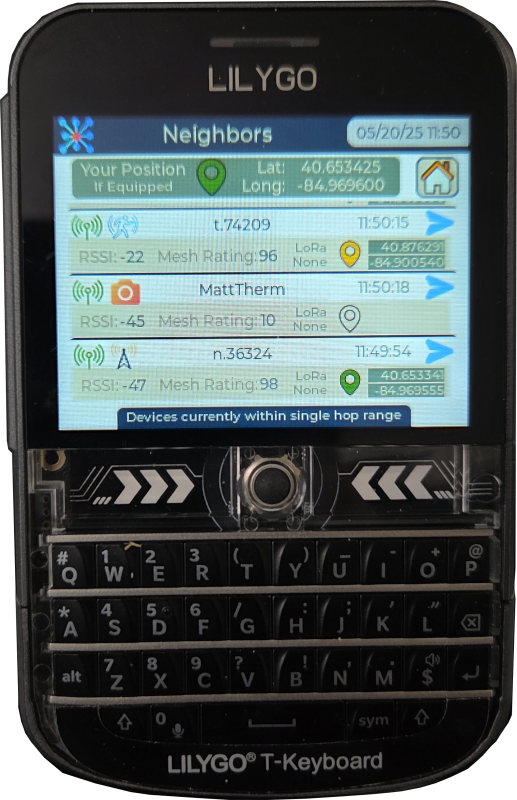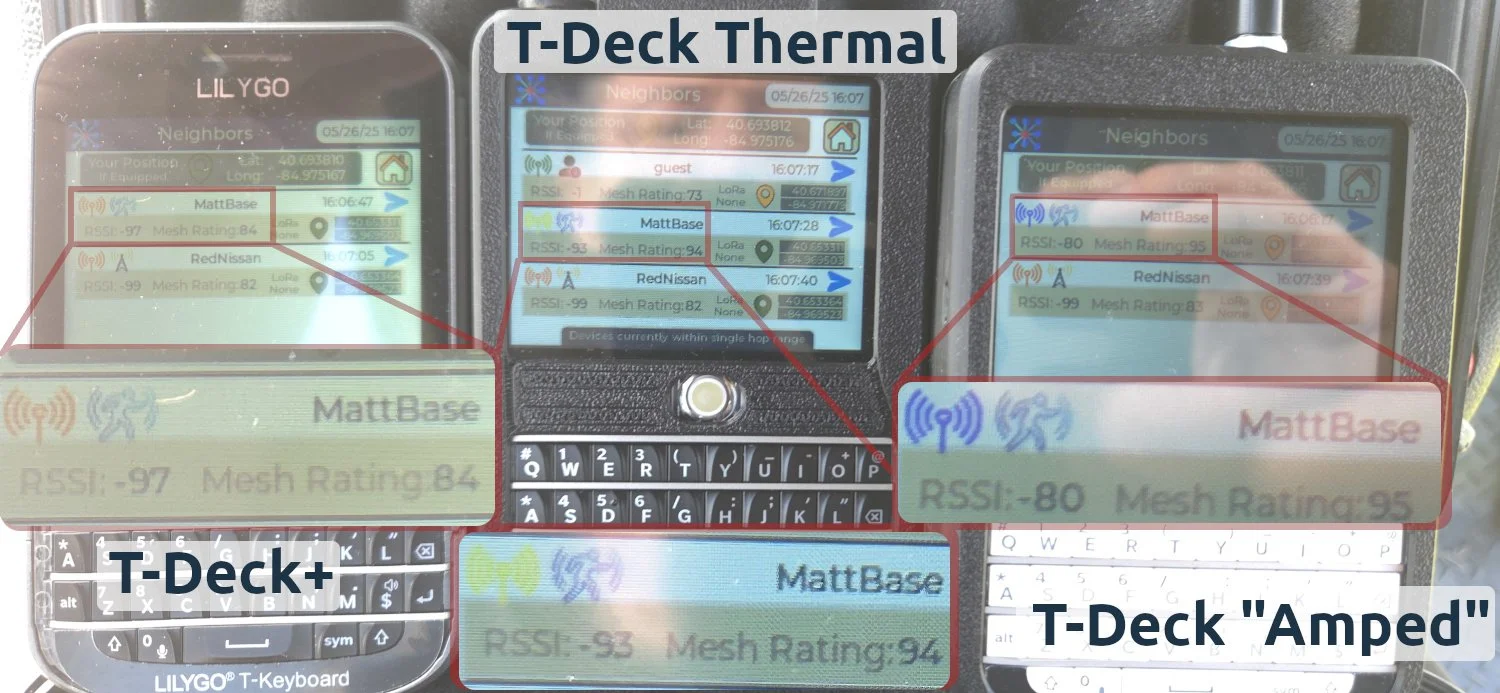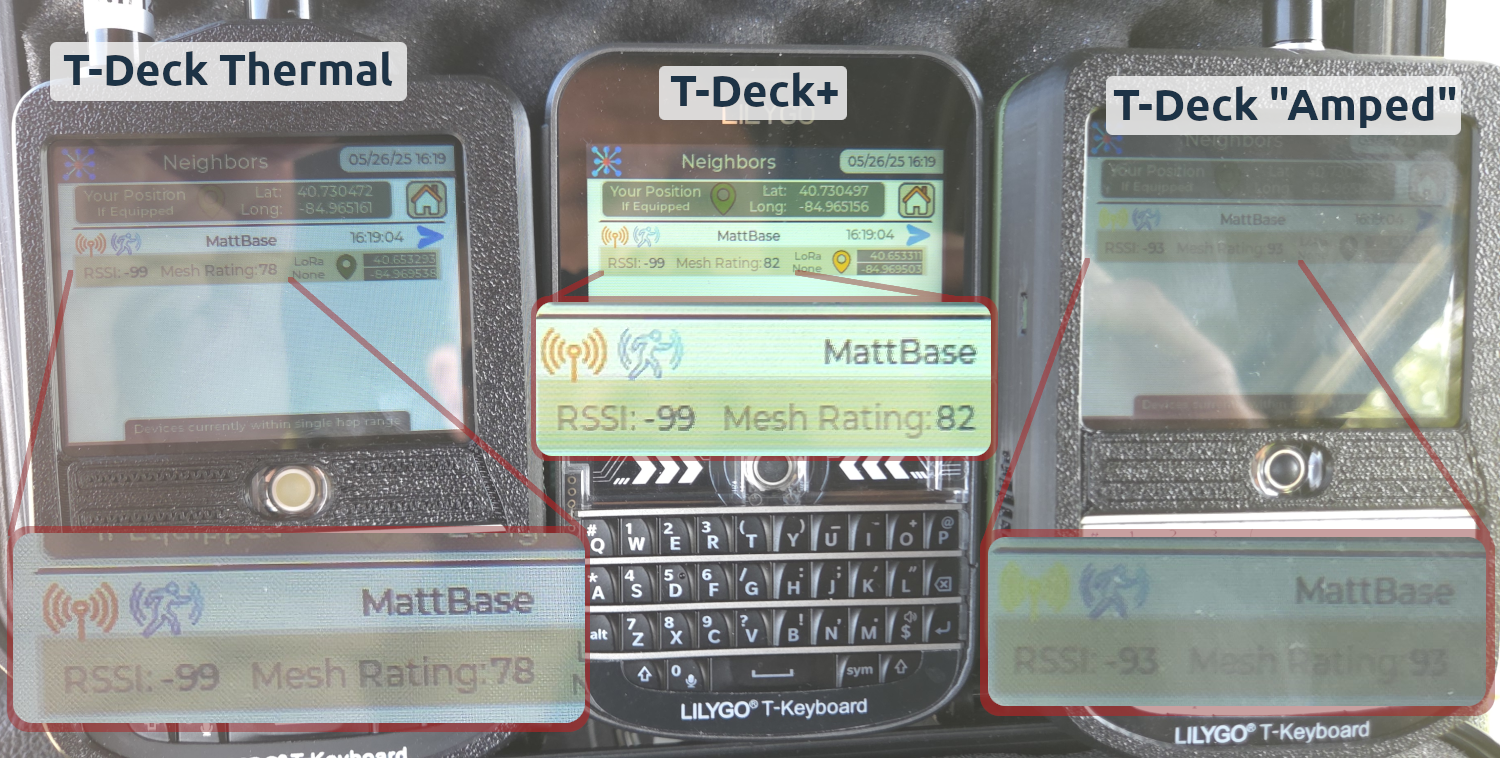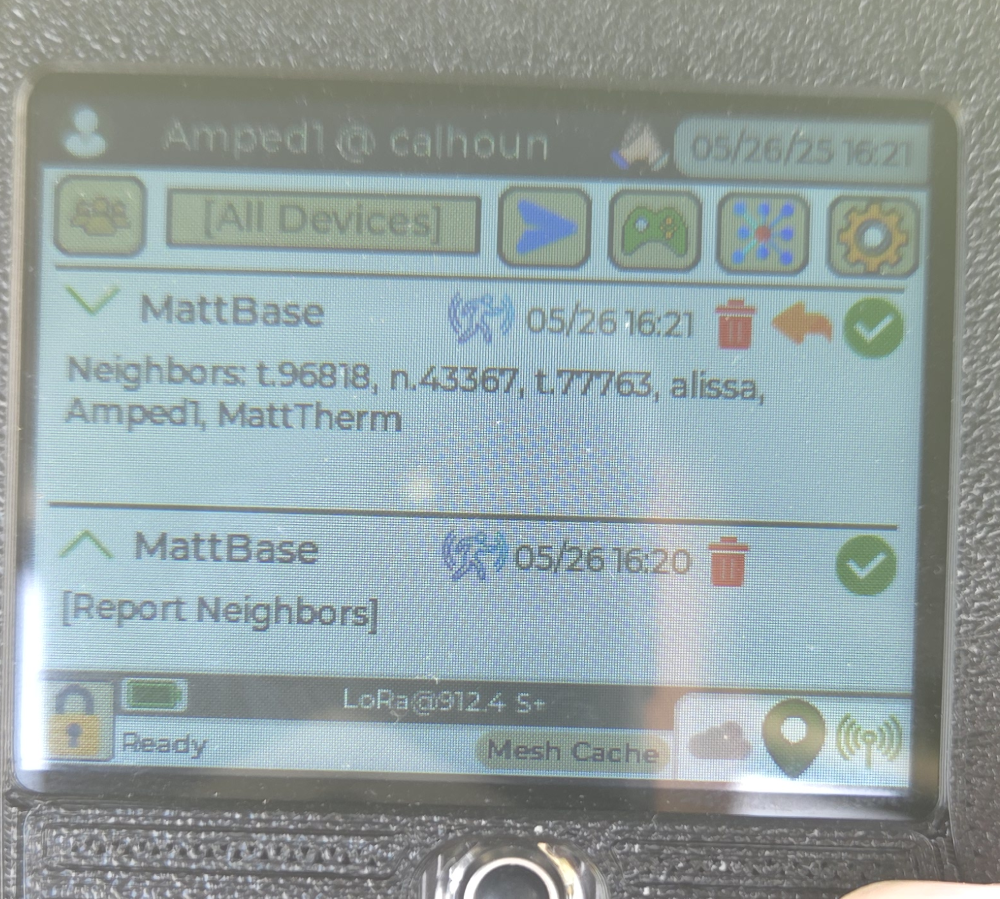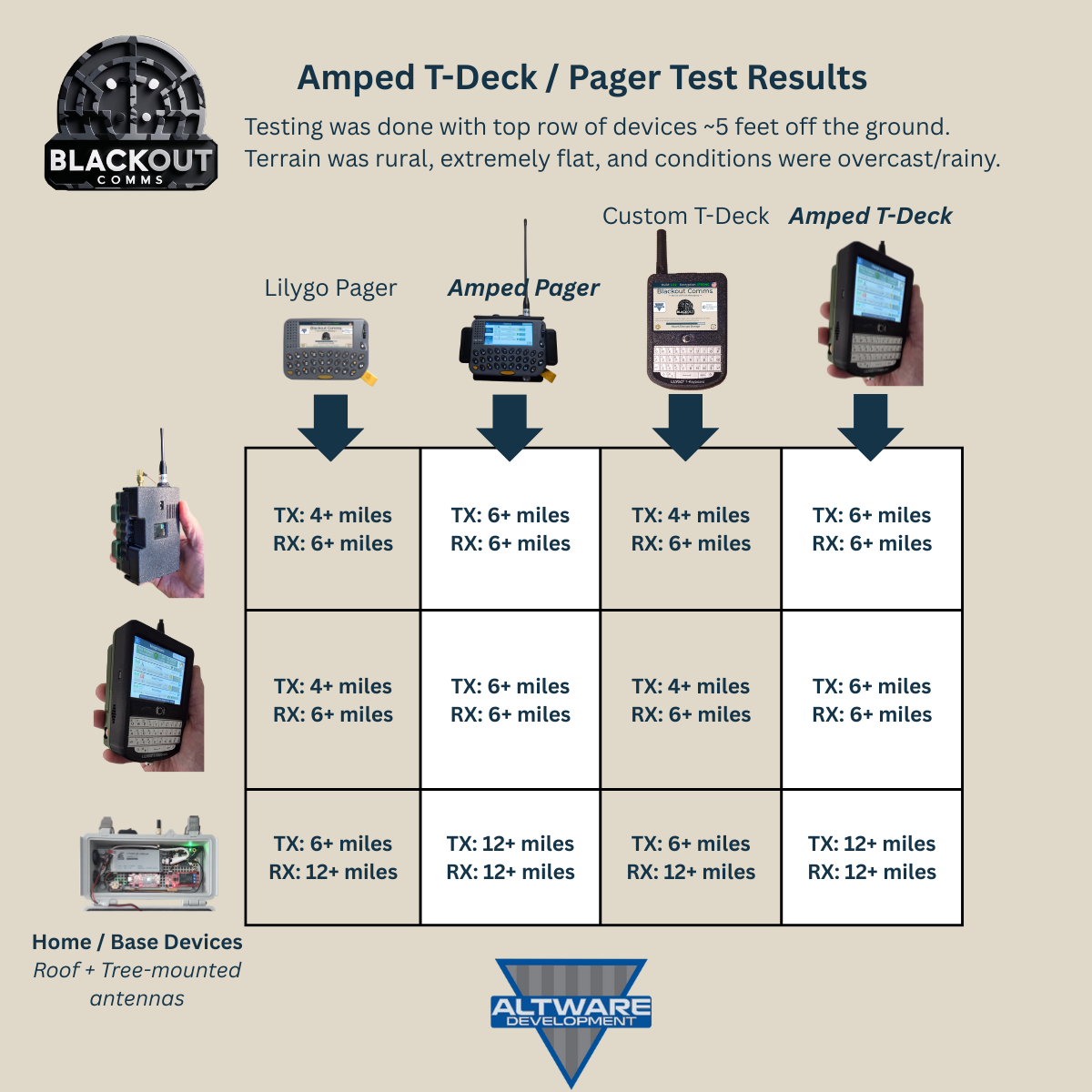Air Buddy LoRa IOT 1 Watt Amplifier
The Air Buddy 1 Watt 5 Volt LoRa amplifier is perfect for embedding in an off-grid handheld texting device, or any LoRa application physical space is low or where 5v is more convenient than 12v.
Although it was originally listed as 1W amp, it’s output ranges from ~1 to 3 watts, depending on how many volts you supply.
Update: This AirBuddy amp delivered encrypted LoRa mesh packets 32 miles in recent drone-based tests.
About This LoRa Amplifier
Specs
Cost (2025): $27 (Amazon, Ali Express)
Frequency: 850 MHz - 932 MHz
Output Power: 31.5dBm (1.4w) @ 3.7v; 33.5dBm (2.3w) @ 5.0v; 34.5dBm (2.8w) @ 6.0v
Gain: 11 dB RX, 5-11 dB TX (adjustable)
Indicator LEDs: Green = RX, Blue = TX
Current: RX: 10mA, TX: <= 720mA
What’s Included
Amp
DC Cable with bare wire ends
Mesh / LoRa Amp Testing
Methodology
As a mesh communication firmware developer, my only interest is really whether this amp plays well with LoRa mesh applications. My testing is pragmatic and focuses on reliability of encrypted mesh deliveries (one way and 2 way) at various distances, and that is really all.
As you can see in the screenshots here, the Blackout Comms mesh firmware allows me to see a live view of which devices/nodes I’m receiving pings from. I’m also able to send messages, which return an ECDSA signed confirmation (shows as check mark), so I know for a fact the message was received and validated, without physically looking at the distant device.
My “Base Station” (a mesh node)
All tests with this AirBuddy amp were done by viewing signal strength, attempting direct messages, and receiving direct messages/broadcasts/delivery confirmations to & from my fixed position base station.
This base station isn’t the subject of these tests, but since it’s involved, I’m showing it here. It’s composed of a Blackout Comms Heltec e290 Vision Mesh Node, 20 watt amp, and 84” roof mounted omni antenna.
The Test unit
Since the size of this unit is perfect for embedding into a handheld/pocket-sized device, I decided to test this with a Lilygo T-Deck.
I redesigned the back of the 3D-printable T-Deck enclosure to accommodate the AirBuddy amp, an additional 2000 mAh LiPo battery, and a charge controller / 5v booster.
In order to guarantee no “brownout” situations where the amp and T-Deck compete for current during a transmission, I decided to use a second battery and charge controller for the amp.
It may be entirely possible to get by with a single battery, but I will revisit that at some point later.
I used a proven, well-tested 17cm omni rubber ducky Lora antenna for the test unit.
Comparison Units
The side-by-side RSSI comparison tests were done using twi similar devices.
T-Deck Plus: Unmodified T-Deck+, with internal antenna
T-Deck Thermal: Same Rubber ducky external antenna, identical in all ways, except that it has an onboard thermal camera and neither the amp nor the amp-related parts (extra battery, etc).
Send / Receive Distance Results
For the first round of testing, I performed some quick RSSI (received strength signal indicator) comparisons at various distances. This would give an easy indication of whether the amp helped, hurt, or made no difference with regard to receiving.
Since the Air Buddy specs show a gain of 11 dBm for RX, I expect if I have this amped test unit next to non-amped T-Decks, the amped T-Deck should show a better RSSI for my base station from just about anywhere within range.
For RSSI, close to zero is good, -90 is better than -99.
4.5 km Distance
I expected no problem at this distance unless there was some interference caused by the amp. That is clearly not the case here, as the amp shows a marked improvement over non-amped.
The Amped T-Deck excels at 4.5 km
T-Deck+ : -97
T-Deck Thermal: -93
T-Deck Amped: -80
8.5 km Distance
The amped T-Deck is still showing a good signal at -93. More importantly, it’s clearly outperforming the similarly equipped thermal.
8.5 km is getting near the limit for T-Deck+ internal antenna, as we can see here. The thermal T-Deck also shows -99, but prior testing has shown it to be reliable at this distance, even with the low RSSI.
Certainly, sending/receiving would be no trouble for the amped unit at this distance.
The Amped T-Deck excels at 8.5 km
T-Deck+ : -99
T-Deck Thermal: -99
T-Deck Amped: -93
Can the Base Station See Me - Yes
At 8.5 km, I fire off a remote command/query from the amped T-Deck to the base station, asking it to report all live currently-in-range devices.
I get instant signed delivery confirmation, which is good. In less than a minute, I get the base stations full response, which includes both the amped T-Deck and the thermal unit, but not the T-Deck+.
It’s likely the base station intermittently sees the T-Deck+ from here, but clearly it’s got no problem seeing the two T-Decks with external antennas.
This helps to validate my test results so far, as it’s from the base station’s perspective instead of the T-Decks’.
Send / Receive Distance Results
These results are from sending and receiving encrypted text messages and signed delivery confirmations between the amped T-Deck, amped Pager, and base station(s) at various distances.
The amped T-Deck was about 4 feet off the ground for all tests.
Note about Testing
The packets/pings/etc that are sent get back an instant ack packet, have an expiry, encryption, hash/signatures..there is simply no way any RF could be mistaken for a Blackout Comms packet or message.
After the message is sent, the recipient device sends back a unique and signed confirmation of receipt, which again..it’s unmistakable and unfakeable, so I’m quite confident in these results.
These next results are from sending and receiving encrypted pings between an amped Altware Link and base station(s) at various distances.
The amped Altware Link was mounted to a drone and hovering 120 meters off the ground for all tests.
Battery Life
~48 Hours Per Charge
Using a 2000 mAh 3.7v lipo battery “boosted” to 5v
Running Blackout Comms as a “typical” user
Using a separate battery for the T-Deck
Battery life is obviously going to depend on the battery size you’re using and how efficient the firmware (or hardware) that’s pushing signals through the amp is.
The battery I used in testing was only powering the AirBuddy amp and a tiny led on the charge controller. In that scenario, I can get roughly 48 hours on a single charge, running Blackout Comms firmware.
Conclusion
I rate this amp extremely high for use with Blackout Comms Encrypted Mesh firmware, T-Deck, and the rubber ducky antenna. I’ve tested the same amp with various other antennas (smaller and larger) and all combinations have performed very well.
It seems to perform better than the Sunhans 1 watt LoRa amp, in a smaller form factor and lower voltage, making it more suitable for handheld encrypted text comms.
Longevity-wise, I’ve been using 4-5 units with these amp off and on for over 6 months now, and have yet to have one of them get hot, fail, or have any issue.







